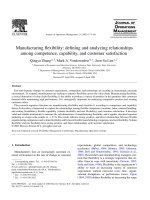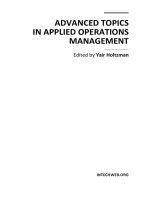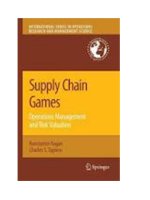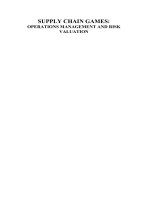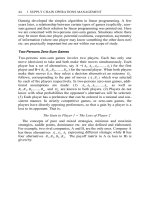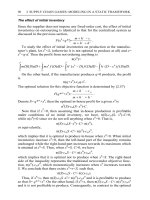Manufacturing flexibility operations management
Bạn đang xem bản rút gọn của tài liệu. Xem và tải ngay bản đầy đủ của tài liệu tại đây (267.56 KB, 19 trang )
Journal of Operations Management 21 (2003) 173–191
Manufacturing flexibility: defining and analyzing relationships
among competence, capability, and customer satisfaction
Qingyu Zhang a,1 , Mark A. Vonderembse b,∗ , Jeen-Su Lim c,2
a
Department of Economics and Decision Sciences, Arkansas State University, State University,
Arkansas, AR 72467, USA
b Department of Management, The University of Toledo, Toledo, OH 43606, USA
c The University of Toledo, Toledo, OH 43606, USA
Received 25 April 2001; accepted 1 April 2002
Abstract
Fast and dramatic changes in customer expectations, competition, and technology are creating an increasingly uncertain
environment. To respond, manufacturers are seeking to enhance flexibility across the value chain. Manufacturing flexibility,
a critical dimension of value chain flexibility, is the ability to produce a variety of products in the quantities that customers
demand while maintaining high performance. It is strategically important for enhancing competitive position and winning
customer orders.
This research organizes literature on manufacturing flexibility and classifies it according to competence and capability
theory. It describes a framework to explore the relationships among flexible competence (machine, labor, material handling,
and routing flexibilities), flexible capability (volume flexibility and mix flexibility), and customer satisfaction. It develops
valid and reliable instruments to measure the sub-dimensions of manufacturing flexibility, and it applies structural equation
modeling to a large-scale sample (n = 273). The results indicate strong, positive, and direct relationships between flexible
manufacturing competence and volume flexibility and between flexible manufacturing competence and mix flexibility. Volume
flexibility and mix flexibility have strong, positive, and direct relationships with customer satisfaction.
© 2002 Elsevier Science B.V. All rights reserved.
Keywords: Empirical research; Flexibility; Management of technology; Manufacturing; Operations strategy
1. Introduction
Manufacturers face an increasingly uncertain external environment as the rate of change in customer
∗ Corresponding author. Tel.: +1-419-530-4139;
fax: +1-419-530-7744.
E-mail addresses: (Q. Zhang),
(M.A. Vonderembse),
(J.-S. Lim).
1 Tel.: +1-870-972-3416.
2 Tel.: +1-419-530-2922.
expectations, global competition, and technology
accelerates (Huber, 1984; Skinner, 1985; Jaikumar,
1986; Doll and Vonderembse, 1991; Germain et al.,
2001). Researchers and manufacturing managers contend that flexibility is a strategic imperative that enables firms to cope with uncertainty (Gerwin, 1987;
Sethi and Sethi, 1990). Flexibility is the organization’s
ability to meet an increasing variety of customer
expectations without excessive costs, time, organizational disruptions, or performance losses. Upton
(1994, 1995) defines flexibility as increasing the range
0272-6963/02/$ – see front matter © 2002 Elsevier Science B.V. All rights reserved.
PII: S 0 2 7 2 - 6 9 6 3 ( 0 2 ) 0 0 0 6 7 - 0
174
Q. Zhang et al. / Journal of Operations Management 21 (2003) 173–191
of products available, improving a firm’s ability to respond quickly, and achieving good performance over
this wide range of products.
To attain the type of flexibility that customers
want (i.e. quick delivery of a variety of high-quality,
low-cost products), organizations seek value chain
flexibility (Zhang, 2001). Value chain flexibility is
broadly defined to include product development,
manufacturing, logistics, and spanning flexibilities
(Zhang, 2001; Day, 1994). It focuses primarily on
filling customer orders rather than on merely improving the efficiency and effectiveness of equipment and
processes. Such a focus requires manufacturing firms
to develop cross-functional and cross-company efforts
that eliminate bottlenecks, increase responsiveness,
and create a level of performance that enables firms
to build competitive advantage (Blackburn, 1991;
Hamel and Prahalad, 1989).
Manufacturing flexibility, the focus of this study, is
the ability of the firm to manage production resources
and uncertainty to meet customer requests (Behrbohm,
1985; Gerwin, 1993; Kathuria and Partovi, 1999;
Hill, 1994; D’Souza and Williams, 2000; Koste and
Malhotra, 1999). Sethi and Sethi (1990) contend that
manufacturing flexibility is a hard-to-capture concept,
and Upton (1995) believes that confusion and ambiguity about this concept inhibit its effective management.
Slack (1983, 1987) distinguishes resource flexibility (e.g., machine flexibility) from systems flexibility
(e.g., mix flexibility). Correa and Slack (1996) define the attributes of systems flexibility (range and
response) and types of systems flexibility (e.g. product mix and production volume). Different descriptors
for manufacturing flexibility overlap; as an example,
process flexibility intersects with operational flexibility. Some descriptors are aggregates of others; process
flexibility includes routing flexibility, machine flexibility, and material handling flexibility. The concept
of manufacturing flexibility is confounded because the
attributes of flexibility (i.e. range, mobility, and uniformity) and the components of flexibility (e.g. machine
flexibility and volume flexibility) are often mingled
(Barad, 1992; Gupta, 1993; Benjaafar, 1994). This imprecise language makes it difficult to develop valid
and reliable measures of manufacturing flexibility and
to improve theory development.
Clear definitions and accurate measures are needed
to construct and test theory related to manufacturing
flexibility. The literature on this important subject
is accumulating including case studies (Maffei and
Meredith, 1995), industry specific studies (Suarez
et al., 1996), and mathematical models (Kumar, 1987;
Benjaafar and Ramakrishnan, 1996; Gupta, 1993;
Jordan and Graves, 1995; Byrne and Chutima, 1997).
Upton (1995, 1997) provides a measure of process
range based on a small sample survey (54 plants).
Suarez et al. (1995, 1996) offer a measure of flexibility on the printed circuit board industry. Gupta and
Somers (1992) develop measures of manufacturing
flexibility based on a large-scale survey, but they do
not clearly describe the dimensions underlying each
type of manufacturing flexibility.
Some researchers emphasize manufacturing flexibility as an internal resource, a competence (Carter,
1986; Das and Nagendra, 1993). They highlight task
sequencing or dispatching disciplines, and they develop flexible machining systems with totally automated functions to cope with uncertainty. But flexible
systems that focus on creating internal competencies (e.g. routing flexibility and machine flexibility)
may not enhance customer satisfaction. Satisfaction
increases as the firm builds capabilities (e.g. mix
flexibility) that provide value to customers. To understand manufacturing flexibility, the internal competencies and external capabilities of flexibility should
be clarified, and relationships between them should
be examined.
This paper contributes to the manufacturing literature by: (1) delineating manufacturing flexibility into
dimensions of flexible manufacturing competence
(machine, labor, material handling, and routing flexibilities) and flexible manufacturing capabil
